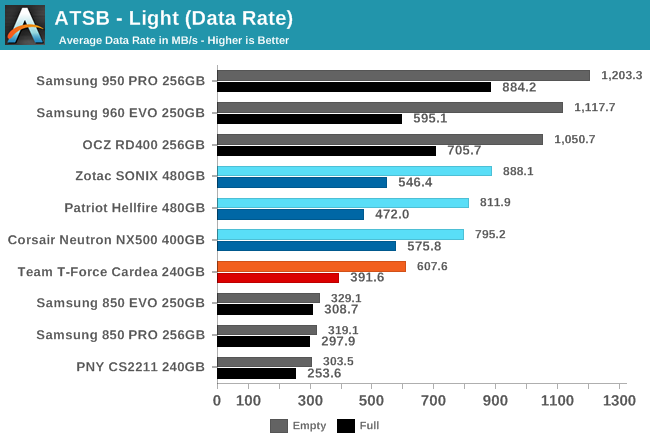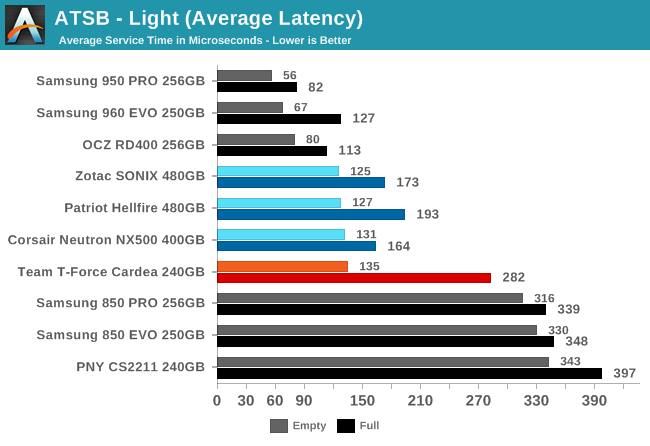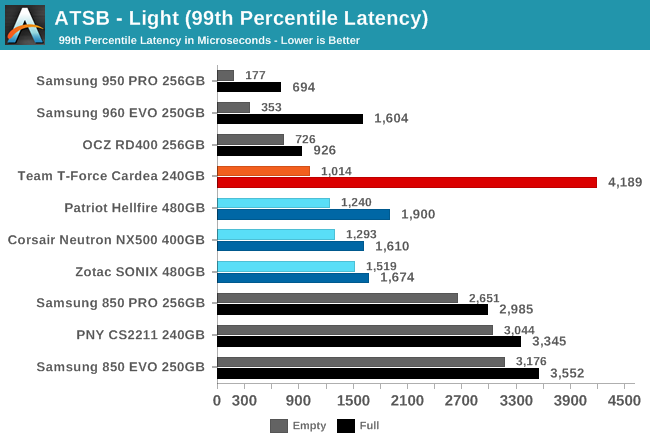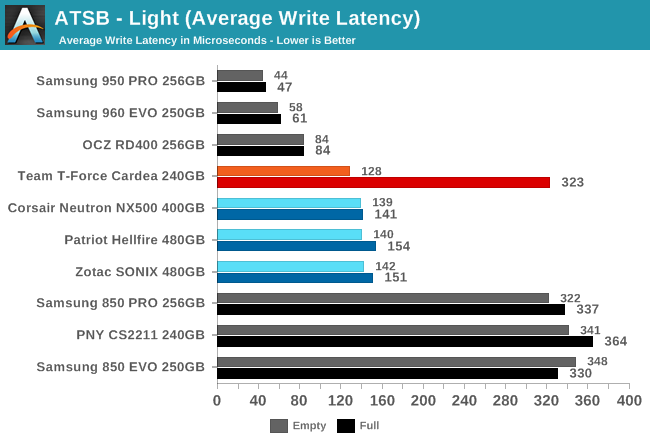The Team Group T-Force Cardea (240GB) SSD Review: Grace Under Write Pressure
by Billy Tallis on September 28, 2017 8:00 AM ESTAnandTech Storage Bench - Light
Our Light storage test has relatively more sequential accesses and lower queue depths than The Destroyer or the Heavy test, and it's by far the shortest test overall. It's based largely on applications that aren't highly dependent on storage performance, so this is a test more of application launch times and file load times. This test can be seen as the sum of all the little delays in daily usage, but with the idle times trimmed to 25ms it takes less than half an hour to run. Details of the Light test can be found here. As with the ATSB Heavy test, this test is run with the drive both freshly erased and empty, and after filling the drive with sequential writes.

On the Light test, the Team T-Force Cardea has a much lower average data rate than the larger Phison E7 drives or any of the other NVMe SSDs in this bunch.


The average and 99th percentile latency scores of the T-Force Cardea are fine when the test is run on an empty drive, but are much worse when the drive is full. The Samsung 960 EVO is also strongly affected by a full drive, but its empty-drive performance is so good that the full-drive scores are still better than any of the Phison E7 drives, especially the T-Force Cardea.


Splitting the average latency into reads and writes reveals that the T-Force Cardea's most acute problem on the Light test is write latency when the drive is full.


The full-drive write latency penalty of the T-Force Cardea is even more apparent when looking at 99th percentile write latency than average write latency. Otherwise, its latency compares favorably against the other Phison E7 drives and is much lower than the SATA drives. The Samsung 960 EVO has a problem with read latency when full, but its write latency stays very good even when full.

The two M.2 Phison E7 SSDs are tied for power consumption, along with the OCZ RD400. The only drives in this bunch that are more power-hungry are the add-in card form factor Phison E7 drives. Samsung's drives are all much more efficient, especially the 850 EVO.










22 Comments
View All Comments
MajGenRelativity - Thursday, September 28, 2017 - link
While this drive doesn't seem too interesting, I'm very interested in your upcoming review on M.2 Thermal Throttling!Pinn - Thursday, September 28, 2017 - link
You should see it by using ~10G files and a ram drive. The Intel card SSD is much more consistent than the M.2 sticks I've tried.Dr. Swag - Thursday, September 28, 2017 - link
Did you guys change some things? Because it feels like some of the results are different, as I remember the 960 evo doing a lot better before...evilspoons - Thursday, September 28, 2017 - link
These results only include the 250 GB 960 Evo, which is the bottom of the line for the 960 series. IIRC the controller is kneecapped due to having a minimum number of NAND chips available and has no parallel processing ability... hence why reviews like this are interesting!Billy Tallis - Thursday, September 28, 2017 - link
Yep. Our initial review of the 960 EVO only included results from the 1TB model, because our first 250GB sample died during testing. The replacement has been working fine, but its performance profile is very different from the 1TB.The relationship between performance and capacity was the biggest reason I wanted to review this drive; it was the first 240GB Phison E7 sample offered to us.
mapesdhs - Thursday, September 28, 2017 - link
It's shocking how much better than 950 Pro is over the 960 EVO a lot of the time. Other reviews show the EVO has issues with steady state performance even at higher capacities. It's why I bagged a lightly used 950 Pro 512GB recently; noticed someone else no doubt delighted at getting another for 130 UKP BIN. :D And of course, the 950 Pro has its own boot ROM (why the heck did Samsung ditch that? Such a useful feature for older chipsets).CheapSushi - Sunday, October 1, 2017 - link
There's an inherent performance and latency difference between MLC (Pro) and TLC (EVO) NAND. Even with updates, better controllers, etc, it is always there (2 bits per cell vs 3 bits per cell).Dr. Swag - Thursday, September 28, 2017 - link
Ah I see. Interesting to see such a large performance gap, though I guess it makes sense.Gasaraki88 - Thursday, September 28, 2017 - link
I wonder why you guys never reviewed the MyDigitalSSD BPX. It's one of the fastest Phison E7 controller SSDs and the cheapest.DanNeely - Thursday, September 28, 2017 - link
MyDigitalSSD would have to send one in for review...